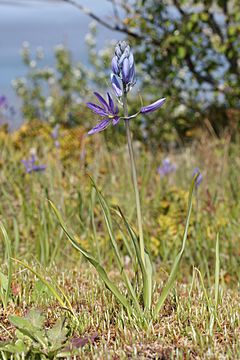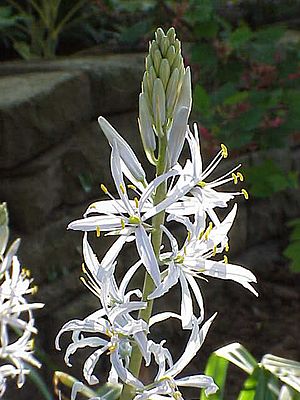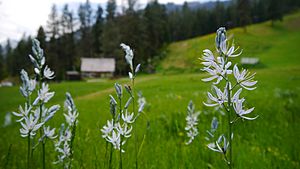Camas facts for kids
Quick facts for kids Camas |
|
|---|---|
 |
|
| Indian camas (Camassia quamash) | |
| Scientific classification |
|
| Kingdom: | Plantae |
| Clade: | Tracheophytes |
| Clade: | Angiosperms |
| Clade: | Monocots |
| Order: | Asparagales |
| Family: | Asparagaceae |
| Subfamily: | Agavoideae |
| Genus: | Camassia Lindl. |
| Type species | |
| Camassia quamash (Pursh) Greene |
|
| Synonyms | |
Camassia is a genus of beautiful plants. They belong to the asparagus family. These plants grow naturally in western North America. People often call them camas, quamash, Indian hyacinth, or wild hyacinth.
You can find camas growing in large groups in wet meadows. They are perennial plants, meaning they live for more than two years. Their long, thin leaves appear early in spring. These leaves can be from 8 to 32 inches (20 to 80 cm) long. In summer, a tall stem grows up to 12 to 50 inches (30 to 127 cm) high. This stem holds many six-petaled flowers. The flowers can be light purple, white, deep purple, or blue. When camas flowers bloom, they can make whole meadows look colorful!
Contents
What is Camas?
Camas plants are known for their pretty flowers. They also have a special bulb underground. This bulb was a very important food source for many Indigenous peoples in North America.
Camas Plant Family
Scientists used to think camas belonged to the lily family. But with new studies, they learned more. Now, Camassia is part of the asparagus family. This shows how much we learn about plants over time!
Types of Camas Plants
There are six main types, or species, of Camassia. Here are a few of them:
- Camassia angusta (prairie camas) - Found in the southern Great Plains.
- Camassia cusickii (Cusick's camas) - Grows in northeastern Oregon and west-central Idaho.
- Camassia leichtlinii (large camas) - Found in British Columbia, Washington, Oregon, and California.
- Camassia quamash (Indian camas) - Common in western Canada and the western United States.
- Camassia scilloides (Atlantic camas) - Grows in eastern and central North America.
Camas: Food and Farming
Camas bulbs were a very important food for Indigenous peoples and early settlers.
How Indigenous Peoples Grew Camas
Indigenous peoples actively managed and grew Blue Camas. They used controlled burning to clear land. This helped camas grow better. They also planted bulbs, tilled the soil, and removed weeds. Families or groups often took care of specific camas plots. These plots sometimes had markers. People respected who owned each plot. Women usually did the work of harvesting the bulbs. They used a pointed wooden tool.
Camas as Food
Camas bulbs were a major food for many Indigenous groups. These included the Nez Perce, Coast Salish, and Blackfoot. Blue Camas was harvested when it was flowering. This was usually in spring or early summer.
After harvesting, the bulbs were often roasted in a pit or boiled. A pit-cooked camas bulb tastes a bit like a baked sweet potato. It is sweeter and has more fibers. Eating too many undercooked bulbs can cause gas. This is because they contain special sugars. When dried, the bulbs could be ground into flour.
It is very important to know that some white-flowered plants look like camas. These are called deathcamas. They are very poisonous! It is easiest to tell them apart when they are flowering.
Camas bulbs even helped members of the Lewis and Clark Expedition survive.
Camas Prairies Today
Long ago, there were huge areas of camas lands. But as more settlers arrived, these lands became smaller. This was due to farming and cattle grazing. Even so, you can still see many camas prairies and marshes today.
Camas in Gardens
Camas bulbs grow well in gardens. They like soil that drains well and has lots of humus. You can plant them in lightly shaded forest areas. They also grow on rocky outcrops or in open meadows. You might also find them near streams and rivers.
You can divide the plants in autumn. This is done after their leaves have died back. New bulbs should be planted in the autumn. Camas plants also spread by seed, not by runners.
Places Named After Camas
Many places in the Pacific Northwest are named after this plant. These include:
- Camas Valley, Oregon
- The city of Camas, Washington
- Lacamas Creek in southern Washington
- The Camas Prairie in northern Idaho
- Camas County, Idaho
- Kamas, Utah
Camas in Trade and Culture
Camas was a key part of the diet for most Indigenous groups. Not all groups harvested camas themselves. Many traded for it. Indigenous groups who lived where camas grew well, like the Coast Salish, traded it. They exchanged it for other goods, like cedar bark baskets or dried halibut.
Trade among Indigenous cultures was about more than just goods. It also helped build friendships. Ceremonies like the potlatch were important. They showed a person's status and their ability to provide for others. Camas was often traded in large amounts during these events.
See also
 In Spanish: Camassia para niños
In Spanish: Camassia para niños



